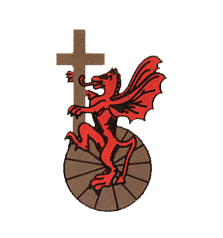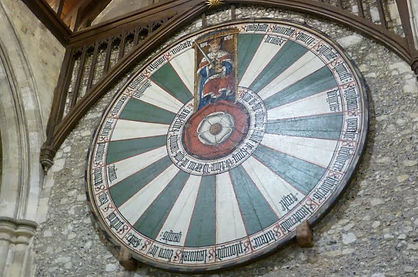 |  |  |  |
|---|
Knights of the Round Table
The Knights were men of courage, honour, dignity, courtesy and nobleness. They protected ladies and damsels, honoured and fought for Kings, and undertook dangerous quests. The Round table was found in patience, humility and meekness. Knights of the Round Table were ' Brothers in Arms'.
The Knights followed a strict code of honour and service;
-
To never do outrage, nor murder
-
Always to flee treason
-
To by no means be cruel but to give mercy unto him who asks for mercy
-
To always do ladies, gentlewomen and widows succor
-
To never force ladies, gentlewomen or widows
-
Not to take up battles in wrongful quarrels for love or worldly goods
There was also twelve basic rules the Knights at the round table had to follow;
-
To never lay down arms
-
To seek after wonders
-
When called upon, to defend the rights of the weak with all one's strength
-
To injure no one
-
Not to attack one another
-
To fight for the safety of one's country
-
To give one's life for one's country
-
To seek nothing before honour
-
Never to break faith for any reason
-
To practice religion most diligently
-
To grant hospitality to anyone, each according to his ability
-
Whether in honour or disgrace, to make a report with the greatest fidelity to truth to those who keep the annals
In theory, they were brothers; however, jealousy, envy and hatred existed with the fellowship. There were enemies within the Round Table as well as those who were not member of the fellowship. In the end, it was adultery committed by one of its members, Lancelot, with Arthur's queen, the enmity of Gawain, and the betrayal of Mordred that finally brought about downfall of Arthur's kingdom.
The Emblem of the Knights
The emblem of the knights of the round table worn round the necks of all the knights
was given to them by king Arthur as part of the ceremony of the men becoming knights.
The Ordersdominant Idea was the love of God, men and noble deeds. The cross on the
emblem was to remind them that they were to live pure and stainless lives, to strive after
perfection, and attain the Holy Grail. The Red dragon of King Arthur represented their
allegiance to the king. The round table was illustrative of the Eternity of God, the
equality, unity and comradeship of the order, and singleness of purpose of all knights.
The Round Table
The round table was not only a physical table, but the highest order of Chivalry at the court of King Arthur. The significance of the Round Table was that no one person, not even King Arthur, would be able to sit at the head of such a table. A round table enforced the concept of equality amongst the Knights of the Round Table. The legend states that King Arthur ordered the Round Table to be built in order to resolve a conflict among his knights concerning who should have precedence. The Round Table was therefore built to ensure that all the Knights of the Round Table were deemed equal and every one of the seats at the Round Table were all seen as highly favoured places.
The Round Table at Winchester
A large round wooden table in the Great Hall at Winchester is
reputed to be King Arthur's Round Table. The Round Table is
madeof 121 separate pieces of oak and measures 18 feet across.
The round table is nearly 3 inches thick and weighs nearly 1.25
tons. Scientific studies have also revealed that a painting of a
King was added to the round table.
The Round table at Winchester provides the Names of
Knights of theRound Table.The Names of Knights of the Round Table are as follows:
-
King Arthur
-
Sir Galahad - This knight was the illegitimate son of Sir Lancelot
-
Sir Launcelot Deulake - Sir Lancelot du Lac who fell in love with Queen Guinevere
-
Sir Gawain - This knight was famed for fighting the Green Knight
-
Sir Percivale - This knight was famed for fighting the Red Knight
-
Sir Lionel - This knight was brother of Sir Bors and cousin to Sir Lancelot
-
Sir Tristram de Lyones - This knight was the son of King Meliodas & Queen Isabelle of Lyonesse - second greatest of the Knights of the Round Table
-
Sir Gareth - Sir Kay was the mentor of this young knight
-
Sir Bedivere - a giant of a Knight
-
Sir Bleoberis - This knight was This knight was an arrogant Knight who later became a hermit
-
Sir Brunor le Noir - aka La Cote Male Taile because he arrived in Camelot wearing an ill-fitting coat which had belonged to his dead father
-
Sir Lucan - This knight was a most loyal and trusted of the Knights of the Round Table
-
Sir Palomides - who was a Saracen knight
-
Sir Lamorak - This knight was This knight was the third greatest of the Knights of the Round Table
-
Sir Bors de Ganis - This knight was brother of Sir Lionel and cousin to Sir Lancelot
-
Sir Safir - This knight was a Christian Knight of Saracen descent
-
Sir Pelleas - This knight was of low birth but one of the bravest of the Knights of the Round Table
-
Sir Kay - King Arthur's foster-brother
-
Sir Ector de Maris - This knight was the Ladies man of the Knights of the Round Table
-
Sir Dagonet - The jester of King Arthur
-
Sir Tegyr - This knight was the cup-bearer of King Arthur
-
Sir Lybyus Dysconyus Sir Guinglain was Sir Gawain's eldest son also known as Le Bel Desconneu - the Fair Unknown
-
Sir Alymere - This knight was totally loyal to King Arthur
-
Sir Mordred - This knight was the treacherous Sir Mordred the son of King Arthur



Above: The Round Table at Winchester
Above: An artists depiction of King Arthur and his Knights at the Round Table
Above: The emblem of the Knights